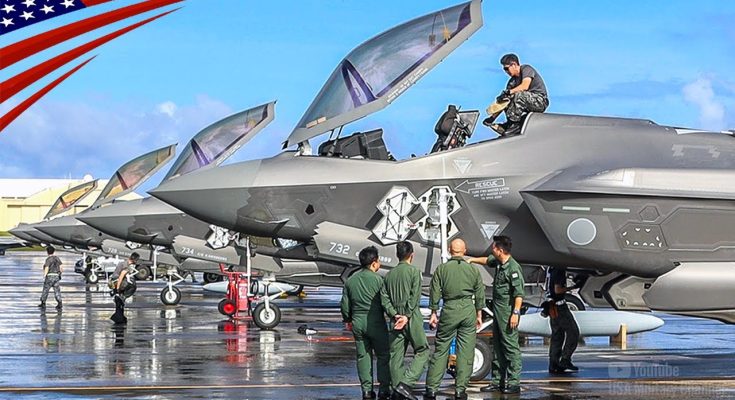Stealth Fighters Unite: Japan & Australia’s F-35s Assemble in Guam for Cope North 2025
In the ever-evolving landscape of modern aerial warfare, multinational cooperation and the integration of advanced combat aircraft are critical to maintaining a strategic edge. One of the most significant recent developments in the Indo-Pacific region has been the assembly of Japan’s and Australia’s F-35 stealth fighters in Guam for the Cope North 2025 exercise. This unprecedented collaboration between two of the United States’ closest allies highlights the growing military cooperation in the region and sends a clear message about the importance of interoperability and readiness in the face of evolving threats.
The Significance of Cope North
Cope North is an annual multinational aerial exercise that takes place in the Pacific and is hosted by the United States. Traditionally, the exercise involves multiple nations working together to enhance air combat readiness, interoperability, and strategic cooperation. The exercise is designed to improve the ability of allied forces to work together in high-intensity combat scenarios, including air-to-air combat, close air support, and large-scale aerial defense operations.
While Cope North has been held for many years, the 2025 iteration marks a significant shift with the participation of Japan and Australia’s F-35 fleets. The inclusion of these fifth-generation stealth fighters represents a new chapter in the exercise’s evolution, emphasizing the growing importance of advanced fighter jets in shaping the future of air warfare in the Pacific region.
F-35s at the Heart of the Exercise
The F-35 Lightning II is one of the most advanced fighter aircraft in the world, combining stealth, advanced avionics, precision strike capability, and multirole versatility. Both Japan and Australia have made substantial investments in the F-35 program, and this collaboration will demonstrate the aircraft’s ability to work seamlessly across international forces.
Japan’s F-35A fleet, part of the Japan Air Self-Defense Force (JASDF), has been integrated into their defense strategy as a deterrent against regional threats and as a means to bolster their air defense capabilities. Australia’s F-35A aircraft, operated by the Royal Australian Air Force (RAAF), similarly represent a critical component of their defense posture, enhancing their ability to conduct long-range strikes, air superiority missions, and counter-surveillance operations in the Pacific region.
The F-35’s stealth capabilities—including its ability to operate in contested environments with minimal risk of detection—will be on full display during the exercise. Its sensor fusion technology, which integrates multiple sources of data into a single, coherent picture for the pilot, will be crucial for improving the situational awareness and tactical decision-making of allied forces working together.
The interoperability between Japan’s and Australia’s F-35s is another key aspect of the exercise. These aircraft will be tasked with missions alongside U.S. F-35s, further demonstrating the growing alliance and the ability to conduct joint operations in high-stakes environments. With the addition of advanced cybersecurity protocols and real-time data sharing, this collaboration represents a new era of global air combat cooperation.
Strengthening Regional Security
The Indo-Pacific has increasingly become a hotspot for geopolitical tensions, especially with rising concerns about China’s military expansion and regional influence. Japan and Australia, both important U.S. allies, have become critical players in efforts to counterbalance these threats. The F-35s at Cope North 2025 are not just about advanced military technology—they also symbolize the commitment of these nations to maintain a secure, free, and open Indo-Pacific.
The exercise will not only improve the combat capabilities of Japan and Australia but also contribute to the strengthening of the trilateral defense relationship between these nations and the U.S. By participating in joint training exercises, these countries will develop a shared understanding of each other’s operational procedures, further enhancing their ability to respond effectively to any potential conflicts in the region.
A Message to Adversaries
The decision to deploy F-35s from multiple nations to Guam for Cope North 2025 sends a powerful message to any potential adversaries in the Indo-Pacific region. The ability of Japan, Australia, and the U.S. to operate together using advanced stealth fighters demonstrates a unified defense posture that would be difficult to challenge. With China’s growing assertiveness in the region, particularly in the South China Sea and Taiwan Strait, this kind of joint exercise serves as a clear signal that the U.S. and its allies are committed to maintaining air superiority and countering any attempts to undermine regional stability.
Moreover, the presence of F-35s in the exercise also highlights the growing shift towards fifth-generation warfare. The advanced sensors, data-sharing capabilities, and operational flexibility of these aircraft are unparalleled, and their integration into multinational operations marks a significant milestone in the future of coalition warfare.
Looking Ahead: The Future of Multinational Exercises
As Cope North 2025 unfolds, the success of the integration of Japan’s and Australia’s F-35s will likely pave the way for future multinational exercises that focus on joint operations and highly advanced, networked warfare. The ability of multiple nations to come together and seamlessly operate their fifth-generation fighters will shape the future of military alliances in the Indo-Pacific, with implications for both regional security and global stability.
In conclusion, the Cope North 2025 exercise is more than just a demonstration of aerial prowess—it represents a new phase of military cooperation among key U.S. allies in the Indo-Pacific. By bringing together Japan and Australia’s F-35 fleets with the U.S., this exercise not only improves military readiness but also reinforces the strength of an interconnected defense network capable of tackling modern threats in the region. As tensions rise, the continued integration of stealth fighter aircraft will be vital in ensuring the security of the Indo-Pacific for generations to come.



